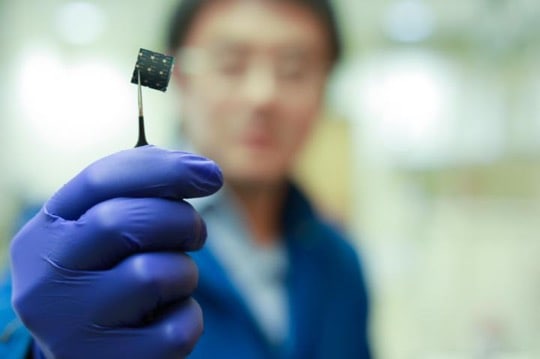
The device, which owes its performance to an innovative double-layer design, is made by spraying a thin layer of perovskite (an inexpensive compound of lead and iodine) onto a commercially available solar cell. The solar cell that forms the bottom layer of the device is made of a compound of copper, indium, gallium and selenide, or CIGS.
In tests carried out at the US Department of Energy’s National Renewable Energy Laboratory, the cell was able to convert 22.4 per cent of the incoming energy from the sun, a record in power conversion efficiency for a perovskite-CIGS tandem solar cell. The previous record, set in 2015 by a group at IBM's Thomas J. Watson Research Center, was 10.9 per cent. The UCLA device's efficiency rate is similar to that of the poly-silicon solar cells that currently dominate the photovoltaics market.
The cell's CIGS base layer, which is about two microns thick, absorbs sunlight and generates energy at a rate of 18.7 per cent efficiency on its own, but adding the one micron-thick perovskite layer improves its efficiency.
The two layers are joined by a nanoscale interface that the UCLA researchers designed; the interface helps give the device higher voltage, which increases the amount of power it can export.
"With our tandem solar cell design, we're drawing energy from two distinct parts of the solar spectrum over the same device area," said Professor Yang Yang who led the research. "This increases the amount of energy generated from sunlight compared to the CIGS layer alone."
Yang added that the technique of spraying on a layer of perovskite could be easily and inexpensively incorporated into existing solar-cell manufacturing processes. "Our technology boosted the existing CIGS solar cell performance by nearly 20 per cent from its original performance," he said. "That means a 20 per cent reduction in energy costs."
He added that the group’s next goal is to develop dual-layer devices approaching 30 per cent power conversion efficiency.
A paper on the research has been published in the journal Science.




Project REvAR aims for energy and clean water from sewage
I struggled to find much detail about <i>this</i> project but it seems to have similarities to another report from 2022...